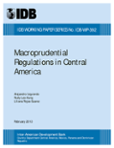Macroprudential Regulations in Central America
Date
Feb 2013
In recent years, and especially in the aftermath of the global financial crisis, a number of emerging market economies have been reforming their regulatory frameworks to adopt recommendations of the macroprudential approach. This paper discusses the potential usefulness of implementing this approach in Central America. Two major results support serious consideration of this type of policy in the region. First, credit booms in Central America are not only as pronounced as in other emerging economies, they are also associated with significantly lower economic growth during downturns. Regulations that minimize the eruption of credit booms and busts are therefore warranted. Second, simulation exercises involving two of the most popular instruments under the macroprudential approach - reserve requirements and dynamic provisioning -suggest significant potential benefits for the stability of financial systems in the region.



